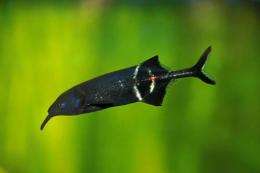June 29, 2012 report
Elephantnose fish's unique retina helps it see through mud

An international group of researchers has been studying the Peters’ elephantnose fish to try to find out how it can see in its murky habitat, and have discovered it has a unique system of crystal-lined cups within its retina.
The Peters’ elephantnose fish (Gnathonemus petersii) is a freshwater elephantfish around nine inches long. It lives in dark, slow-moving, heavily vegetated waters in central and west Africa. The elephantfish family all have extended mouths that resemble the trunks of elephants, and which generate weak electrical fields that help them sense objects in the water.
The eyes of vertebrates have a system of rods and cones in the retina, with the rods being most sensitive to dim light and cones being most effective in bright light and more sensitive to colors and fine details. In most vertebrates either rods or cones are working at any time depending on the light intensity, and so in humans, for example, cones are working in the daytime and rods are working at night. In animals active in the daytime cones predominate, while nocturnal animals have more rods than cones in the retina.
The research team measured the electrical signals produced in the retina of the fish and found that both types of photoreceptors work simultaneously all the time. They also discovered that the cones are grouped in unusual structures — light-reflecting cups with a mirror-like surface made of photonic guanine crystals — and the rods are clustered beneath these reflecting cups.
The research team worked out that the cup arrangement in the elephantnose fish amplifies the light falling on the cones to enable them to work even in dim light, and allows just enough light through to the rods to provide optimal light conditions for them to function.
The group tested the vision of the fish and compared it to that of goldfish, by using a monitor on which they displayed images such as a black expanding circle against a white background. The goldfish and elephantnose fish spotted the object in around the same time. When the images were presented with a grey noise pattern superimposed over them, the elephantnose fish responded to the images more quickly than the goldfish (which are renowned for having good vision).
The elephantnose fish are only capable of seeing relatively large objects because all the cones in each cup see the same image. Lead author, Prof. Dr. Andreas Reichenbach of the Paul Flechsig Institute at the University of Leipzig in Germany, likened their vision to humans being able to see objects only if they were larger than six times the diameter of the full moon. The fish can therefore not see bubbles or small particles of mud and dirt, but they can discriminate large objects moving against a cluttered background, which is exactly the kind of vision they need to avoid predators in their muddy habitats.
The paper is published in the journal Science.
More information: Science 29 June 2012: Vol. 336 no. 6089 pp. 1700-1703 DOI: 10.1126/science.1218072
Journal information: Science
© 2012 Phys.Org



















